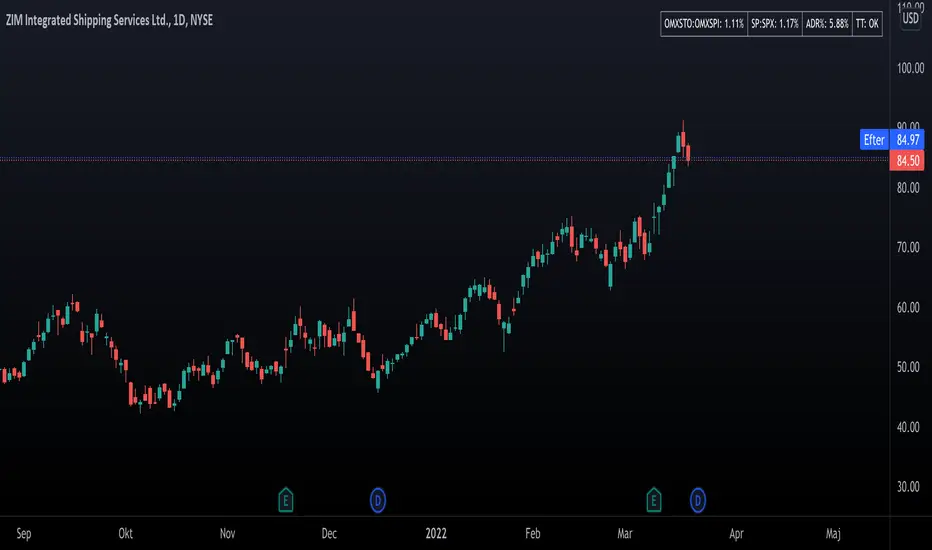OPEN-SOURCE SCRIPT
Updated ADR label

/
// To quote qullamaggie: " High ADR is Gold, low ADR is shit..."
// Hence we display the ADR (Average Daily Range) in percent.
//
// We also calculate and display Long Stop-Loss suggestions.
// 1. Using the ATR times a multiple.
// 2. Using a percentage.
//
// We also calculates the Trend Template as described by Mark Minervini in his book: "Trade like a stock market wizard"
// For a stock to be considered all the rules has to be fullfilled.
// The only rule this indicator doesn't implement is the IBD Relative Strength ranking.
//
// Rules:
// close > MA-50 > MA-150 > MA-200 , each condition that is true gets one point.
// The current stock price is at least 30 percent above its 52-week low, gets one point
// The current stock price is within at least 25 percent of its 52-week high, gets one point.
// The 200-day moving average line is trending up for at least 1 month (preferably 4–5 months), gets one point.
//
// When we get 6 points, all the rules are fullfilled and we display an OK;
// else we show the number of points (X).
//
// To quote qullamaggie: " High ADR is Gold, low ADR is shit..."
// Hence we display the ADR (Average Daily Range) in percent.
//
// We also calculate and display Long Stop-Loss suggestions.
// 1. Using the ATR times a multiple.
// 2. Using a percentage.
//
// We also calculates the Trend Template as described by Mark Minervini in his book: "Trade like a stock market wizard"
// For a stock to be considered all the rules has to be fullfilled.
// The only rule this indicator doesn't implement is the IBD Relative Strength ranking.
//
// Rules:
// close > MA-50 > MA-150 > MA-200 , each condition that is true gets one point.
// The current stock price is at least 30 percent above its 52-week low, gets one point
// The current stock price is within at least 25 percent of its 52-week high, gets one point.
// The 200-day moving average line is trending up for at least 1 month (preferably 4–5 months), gets one point.
//
// When we get 6 points, all the rules are fullfilled and we display an OK;
// else we show the number of points (X).
//
Release Notes
Added the display of the change in percent of two selected Indices.Release Notes
We calculate the max allowed position- and risk size based on an optional Account size, a position percentage and a risk percentage, together with a suggested Stop Loss.
We also allow for expressing the Account size in some currencies other than USD.
Release Notes
Adding the display of the number of Shares to buy to fill up the max position size.Release Notes
Cleaned up the display by using a table located in the upper right corner.Release Notes
Correcting the Indices diff calculation.Release Notes
Added possibility to control the location of the Display; possible positions are: Top/Middle/Bottom RightRelease Notes
Renamed the name; new name: 'Quick Stats'.Cleaned up the table layout and removed the
calculation of Position Sizes (moved to a separate
indicator: 'Position Sizes')
Open-source script
In true TradingView spirit, the creator of this script has made it open-source, so that traders can review and verify its functionality. Kudos to the author! While you can use it for free, remember that republishing the code is subject to our House Rules.
Disclaimer
The information and publications are not meant to be, and do not constitute, financial, investment, trading, or other types of advice or recommendations supplied or endorsed by TradingView. Read more in the Terms of Use.
Open-source script
In true TradingView spirit, the creator of this script has made it open-source, so that traders can review and verify its functionality. Kudos to the author! While you can use it for free, remember that republishing the code is subject to our House Rules.
Disclaimer
The information and publications are not meant to be, and do not constitute, financial, investment, trading, or other types of advice or recommendations supplied or endorsed by TradingView. Read more in the Terms of Use.